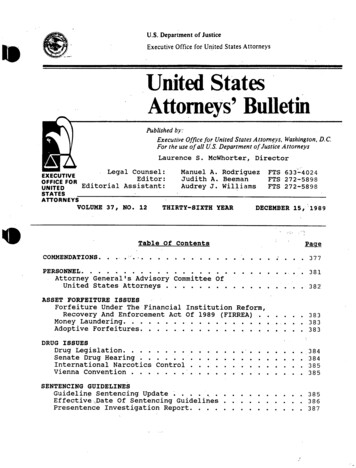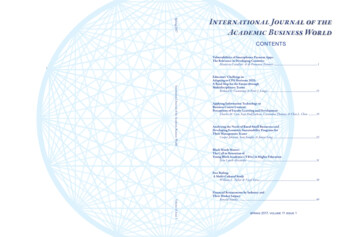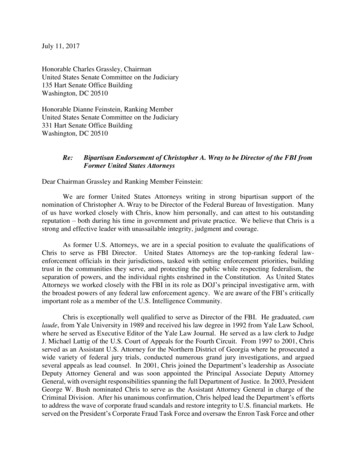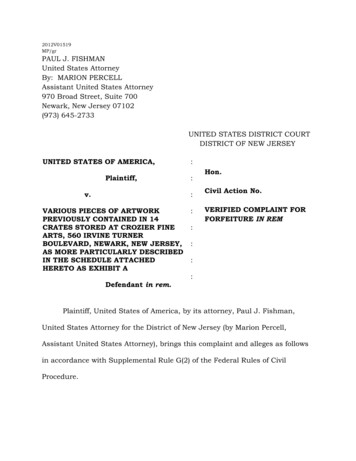
Transcription
DS FBIC PIA1. Contact InformationA/GIS Deputy Assistant SecretaryBureau of AdministrationGlobal Information Services2. System Information(a) Name of system: Diplomatic Security Federal Bureau of Investigations Connectivity(b) Bureau: DS/EX(c) System acronym: DS FBIC(d) iMatrix Asset ID Number: 4516(e) Reason for performing PIA: New system Significant modification to an existing system To update existing PIA for a triennial security reauthorization(f) Explanation of modification (if applicable): Modified to capture all Biometrics softwarethat utilize the DS FBIC boundary.The previous iteration of DS FBIC included the Crossmatch Live Scan ManagementSystem (LSMS) only. The new iteration of DS FBIC includes new subcomponents thatwill increase the avenues for data entry into FBIC as noted in Section 3c.3. General Information(a) Does the system have a completed and submitted Security Categorization Form (SCF)? Yes No - Contact IRM/IA at IASolutionCenter@state.gov for assistance.(b) What is the security Assessment and Authorization (A&A) status of the system?DS FBIC has a full authorization to operate as of September 21, 2018 with an expiry dateof September 30, 2021.(c) Describe the purpose of the system:DS FBIC contains several biometric software applications to support case investigationsactivities in support of the Bureau of Diplomatic Security’s (DS) various missions.Persons or subjects of the investigations can be US, Non-US, contractor, governmentemployee (see. Section 4a boxes, everything is selected) tied to case investigations.
DS FBICJuly 2020While each Biometric Software is different in design, each system collects and sends thesame PII data utilizing the same boundary.DS FBIC Components:1. Crossmatch Live Scan Management System (LSMS) for Windows. LSMS is abiometrics collection software, installed on OpenNet workstations.2. ARES is a biometrics collection software able to be installed on approvedAndroid Phones to facilitate mobile enrollments3. ARES Gateway is a database used for the consolidation and submissionmanagement of mobile biometric enrollments to external agencies such as theFBI (organization that owns FBIC).These applications are used by Diplomatic Security to collect Biometric and Identitydata. The information collected within these applications is sent to external federalauthoritative databases to establish and verify an individual’s identity and criminalrecords in support of vetting and law enforcement efforts.(d) Describe the personally identifiable information (PII) that the system collects, uses,maintains, or disseminates:DS FBIC collects and stores the following information: Full name Date of birth Country or place of birth Country of Citizenship Gender Physical description (hair and eye color, height and weight) Passport number Race Global Unique Identifier (GUID) Telephone numbers Email Address Office of employment Social Security Number or other national identification numbers Driver’s license number Biometric data: Fingerprints, Irises and facial templates/images.However, as PII collected from non-U.S. citizens is not covered by the provisions of thePrivacy Act and the E-Government Act, the remainder of this PIA addresses the PIIcollected and maintained by DS FBIC on U.S. persons only. DS FBIC also collects andmaintains the responses received from external agencies.(e) What are the specific legal authorities and/or agreements that allow the information to becollected?PIA Template v1.1Page 2
DS FBICJuly 2020The legal authority for the collection of information is the same as that which establishedthe Bureau of Diplomatic Security: The Omnibus Diplomatic Security and AntiterrorismAct of 1986 (Pub. L. 99-399; 22 U.S.C. 4801, et seq. (1986)) as amended. Thislegislation is cited in 12 Foreign Affairs Manual (FAM) 012, Legal Authorities.Additional authorities are as follows:- 26 Code of Federal Regulations (CFR) 601.017, Criminal Investigation Functions, April1, 2007- 22 U.S. Code 2709, Special Agents, January 3, 2012(f) Is the information searchable by a personal identifier (e.g., name or Social Securitynumber)? Yes, provide:- SORN Name and Number: See Below- SORN publication date (found under the Volume Number and above the PublicNotice Number on the published SORN): See Below STATE-31, Human Resources Records, July 19, 2013STATE-36, Security Records, June 15, 2018 No, explain how the information is retrieved without a personal identifier.(g) Does the existing SORN need to be amended to reflect the inclusion of this new orsignificantly modified system? Yes NoIf yes, please notify the Privacy Division at Privacy@state.gov.(h) Is there a records retention schedule submitted to or approved by the National Archivesand Records Administration (NARA) for this system? Yes No(If uncertain about this question, please contact the Department’s Records Officer atrecords@state.gov .)If yes provide:- Schedule number (e.g., (XX-587-XX-XXX)): See Below- Length of time the information is retained in the system: See Below- Type of information retained in the system: See BelowSchedule NumberLength of TimeA-03-005-23 PersonnelSecurity and AccessClearance RecordsTemporary. Destroy1 year afterconsideration of thecandidate ends, butlonger retention isauthorized ifPIA Template v1.1Type of InformationDescription: Records of people not issuedclearances. Includes case files of applicantsnot hired.Records about security clearances, and otherclearances for access to Government facilitiesor to sensitive data, created to support initialPage 3
DS FBICJuly 2020required for businessuse.favorable eligibility determinations, periodicreinvestigations, or to implement a continuousevaluation program.Includes: questionnaires summaries of reports prepared by theinvestigating agency documentation of agency adjudicationprocess and final determinationNote: GRS 3.2, Information Systems SecurityRecords, items 030 and 031, coversInformation system access records.Exclusion: Copies of investigative reportscovered in items 170 and 171.Disposition: Temporary. Destroy 5 years afteremployee or contractor relationship ends, butlonger retention is authorized if required forbusiness use. (Supersedes GRS 18, item 22a)DispAuthNo: DAA-GRS-2017-0006-0025(GRS 5.6, item 181)A-11-012-19aInvestigativeManagement System(IMS)Temporary.Destroy/deletemaster file data 100years after casecloses. NOTE: If theBureau ofDiplomatic Securitybecomes aware ofany significant orprecedent-settingcases that maywarrant preservation,notify NARA for anindependentappraisal of thesecases.An electronic tracking system used to controland document criminal investigations.Information covers case background, caseallegations, case documented interviews,evidence, surveillance videos/audio tapes,pictures, post records and foreign governmentrecords, and related investigative information.A-11-027-01a DOSClearance SystemDisposition: N/AThe DOS Clearance System (DOSC) is thepersonnel security and suitability processingsystem and archive. The DOSC contains thesecurity and suitability case files with theirPIA Template v1.1Page 4
DS FBICB-08-002-03aSecurity Case FilesJuly 2020Disposition: Cardand destroy 1 yearafter case is closed.associated forms, reports, analysis,memoranda, worksheets, authorizations, etc. Ittracks the various processing steps andactivities involved with investigations and thedeterminations made regarding securityclearances, public trust certifications andsuitability. The system covers the entireprocess and interfaces with other externaldatabases for information.Description: Security investigative filesinvolving attempted penetration, fraud, loss ofdiplomatic pouches, and other cases notpertaining to investigations of individuals whoare or may be employed by the Department orother Federal agencies. The record copies ofthese cases are retained by the Office ofSecurity.4. Characterization of the Information(a) What entities below are the original sources of the information in the system? Pleasecheck all that apply. Members of the Public U.S. Government employees/Contractor employees Other (people who are not U.S. Citizens or LPRs)(b) If the system contains Social Security Numbers (SSNs), is the collection necessary? Yes No- If yes, under what authorization?Bureau of Diplomatic Security: The Omnibus Diplomatic Security and Antiterrorism Actof 1986 (Pub. L. 99-399; 22 U.S.C. 4801, et seq. (1986))(c) How is the information collected?Authorized individuals obtain biometric (fingerprints, irises and facial images) data usingfingerprint and iris/facial capture devices. The biographical information is obtained byauthorized individuals. All data entered/uploaded into DS FBIC by authorized individualsis part of their official duties, to facilitate embassy/post access, vetting, and in support ofexisting law enforcement investigative efforts. The PII is collected on persons or subjectsof the investigations who can be US citizens, Non-US citizens, contractors, governmentemployees (see. Section 4a boxes, everything is selected) tied to case investigations.The subjects of the investigations are: criminal, persons related to the criminal case e.g.family friends, and background investigations for employment.All phones used in conjunction with FBIC to collect privacy data for various types ofofficial investigations (background, criminal, job related, US persons, Non-US Persons,PIA Template v1.1Page 5
DS FBICJuly 2020persons associated to a case etc.) are government owned phones and connected togovernment owned equipment. The phones connect to the DS managed/govt. ownedMobile Device Manager (MDM), which is a server that is in the DS managed DMZnetwork segment. The MDM connects to OpenNet so the phones can upload the data towhere it needs to go.The phone connection to the MDM is via Virtual Private Network (VPN) and isencrypted. The connection between the MDM and OpenNet is encrypted.(d) Where is the information housed? Department-owned equipment FEDRAMP-certified cloud Other Federal agency equipment or cloud Other- If you did not select “Department-owned equipment,” please specify.(e) What process is used to determine if the information is accurate?Authorized Personnel will review the initial documentation and identification providedto them and validate against proper identification (i.e., embassy badging or nationalidentification card). Any changes to biographical data thereafter will require a newenrollment of the individual, if authorized personnel wish to resubmit the information.In addition, DS FBIC has built in data validation controls to include validity checks toensure all mandatory information has been collected before completion. Sequencechecking and quality controls are conducted against the biometric data collected to ensureproper fingerprints have been collected and the quality of iris/fingerprint data iscompliant with National Institute of Standards and Technology (NIST) SpecialPublication (SP) 800-76, and Data Format for the Interchange of Fingerprint, Facial &Other Biometric Information ANSI/NIST-ITL 1-2011 NIST SP 500-290.(f) Is the information current? If so, what steps or procedures are taken to ensure it remainscurrent?The biographical information is as current as the information received from the datasource. All biometric information collected is current as of the collection date and noadditional steps are taken to ensure it remains current.(g) Does the system use information from commercial sources? Is the information publiclyavailable?No, the system does not use information from commercial sources.(h) Is notice provided to the individual prior to the collection of his or her information?Yes, both civil and criminal subjects are notified prior to the collection of theirinformation. Civil subjects are required to sign a Privacy Act Statement, Criminal Subjectsare notified verbally.PIA Template v1.1Page 6
DS FBICJuly 2020(i) Do individuals have the opportunity to decline to provide the information or to consent toparticular uses of the information? Yes No- If yes, how do individuals grant consent?Civil applicants may decline to submit biometric and biographical data; however thebackground check is often a prerequisite for employment.- If no, why are individuals not allowed to provide consent?Criminal subjects under investigation or suspected of a crime, are not required toprovide consent.(j) How did privacy concerns influence the determination of what information would becollected by the system?The collection of PII is limited to the required components of a civil and criminalinvestigation. These required components can be used for nefarious purposes, whichrequires applying all DoS approved risk mitigation techniques and IT security safeguardsinherent to OpenNet. The application of the DoS approved risk mitigation processes andtechnologies will significantly reduce the likelihood of compromise of the system’sinformation.5. Use of information(a) What is/are the intended use(s) for the information?The intended use of DS-FBIC is to Support Department of State law enforcement andinvestigative efforts. DS-FBIC is used to verify the identity of individuals in a civil orcriminal investigation.(b) Is the use of the information relevant to the purpose for which the system was designed orfor which it is being designed?Yes. It was designed for identity verification.(c) Does the system analyze the information stored in it? Yes NoIf yes:(1) What types of methods are used to analyze the information?N/A(2) Does the analysis result in new information?N/A(3) Will the new information be placed in the individual’s record? Yes No(4) With the new information, will the Department be able to make newdeterminations about the individual that would not have been possible without it? Yes No6. Sharing of InformationPIA Template v1.1Page 7
DS FBICJuly 2020(a) With whom will the information be shared internally and/or externally? Please identifythe recipients of the information.There is no internal sharing.External sharing:The information may be shared with: A Federal, State, or local agency, or other appropriate entities or individuals, orthrough established liaison channels to selected foreign governments.(b)(c)(d)(e)(f)That includes but is not limited to:o Department of Homeland Security (DHS)o Department of Defense (DoD)o Department of Justice (DoJ)o Other agencies and entities involved in national security; U.S. bordersecurity, official government business or federal law enforcementWhat information will be shared?Electronic Biometric transmission (EBT) files contain all information collected within thesystem defined in Section 3(d) of this document. DS FBIC shares an EBT file with allexternal agencies defined in Section 6a of this document.What is the purpose for sharing the information?The purpose for sharing the information collected within DS FBIC is to establish andverify a person’s identity for background, criminal, and case investigative purposes.The information to be shared is transmitted or disclosed by what methods?The information collected is shared by secure transmission methods permitted underDepartment of State policy for the handling and transmission of sensitive but unclassified(SBU) information.What safeguards are in place for each internal or external sharing arrangement?Safeguards in place for External sharing arrangements include secure transmissions usingFIPS 140-2 approved encryptions using Secure Socket Layer (SSL) / Transport layerSecurity (TLS) and encrypted Virtual Private Networks (VPN). Memorandums ofUnderstanding/Agreement (MOU/MOA) are in place with external agencies. Allexternal communications are encrypted. Regularly administered security and privacytraining informs authorized users of proper handling procedures. Audit trails track andmonitor usage and access.What privacy concerns were identified regarding the sharing of the information? Howwere these concerns addressed?The primary risk is misuse by employees and contractors. Misuse may result in oremotional distress for applicants whose PII is compromised. In addition to administrativeburdens, data compromises may escalate to financial loss, loss of public reputation,public confidence, and civil liability for the Department of State and other agencies.PIA Template v1.1Page 8
DS FBICJuly 2020To appropriately safeguard the information, numerous management, operational, andtechnical security controls are in place in accordance with the Federal InformationSecurity Management Act (FISMA) of 2002 and information assurance standardspublished by the National Institute of Standards and Technology (NIST). These controlsinclude memorandum of understanding (MOU) arrangements with external agencies.Access control lists, which define who can access the system, and at what privilege level,are regularly reviewed, and inactive accounts are promptly deleted. Additionally, systemaudit trails are regularly analyzed and reviewed to deter and detect any unauthorizedactivity. An audit trail provides a record of all functions authorized users perform orattempt to perform.7. Redress and Notification(a) What procedures allow individuals to gain access to their information?DS FBIC contains Privacy Act-covered records. Notifications and redress are, therefore,rights of record subjects. Procedures for notification and redress are published in thePrivacy Act System of Records Notice (SORN) STATE-31 and STATE-36, and in rulespublished at 22 CFR 171.31 informing the individual regarding how to inquire about theexistence of records, how to request access to the records, and how to request amendmentof a record. Certain exemptions to Privacy Act provisions for notification and redressmay exist for visa records on grounds pertaining to law enforcement, in the interest ofnational defense and foreign policy if the records have been properly classified, and tocarry out protective responsibilities under 18 U.S.C. 3056. These exemptions arepublished as agency rules at 22 CFR 171.32.(b) Are procedures in place to allow an individual to correct inaccurate or erroneousinformation? Yes NoIf yes, explain the procedures.To the extent that material contained in DS FBIC is subject to the Privacy Act (5 USC552a), individuals can request amendment of material in the system under procedures setforth in (SORN) STATE-31 and STATE-36. This amendment procedure is available onlyto information on non-criminal investigations. All information pertaining to criminalinvestigations is excluded from the Privacy Act under 5 USC 552a (j)(2). Inaccurate orerroneous information in DS FBIC criminal investigative files will only be subject toamendment or correction at the request of the federal law enforcement agency whichoriginated the material.If no, explain why not.(c) By what means are individuals notified of the procedures to correct their information?The mechanism for requesting correction of information is specified in SORN STATE-31and STATE-36 & 22 C.F.R. Part 171. The procedures inform the individual how toPIA Template v1.1Page 9
DS FBICJuly 2020inquire about the existence of records about them, how to request access to their records,and how to request amendment of their record if permissible.8. Security Controls(a) How is the information in the system secured?The system is secured within the Department of State intranet where risk factors aremitigated through the use of defense in depth - layers of security, including management,operational and technical security controls, auditing, firewalls, physical security, andcontinuous monitoring. Internal access is limited to authorized Department of Stateusers, including cleared contractors who have a justified need for the information in orderto perform official duties.Access to applications is controlled at the application level with additional accesscontrols at the database level. All accounts must be approved by the user’s supervisorand the Information System Security Officer. Data shared with other governmentagencies is carefully regulated according to a Memorandum of Understanding/Agreement(MOU/MOA) and an Information Security Agreement (ISA), formally signed byAuthorizing Officers of each agency.Applications are configured according to the State Department Security ConfigurationGuides to optimize security while still providing functionality (complies with federalregulations and the Federal Information System Management Act (FISMA)). ApplicableNational Institute of Standards and Technology (NIST) 800-53 and privacy overlays ofmanagement, operational, and technical controls are in place and are tested as part of thecontinuous monitoring program. Vulnerabilities noted during testing are reportedappropriately and tracked until compliant or acceptably mitigated.(b) Describe the procedures established to limit access to only those individuals who have an“official” need to access the information in their work capacity.To access the system, persons must be authorized users of the Department of State’sunclassified network which requires a background investigation and an applicationapproved by the supervisor and Information System Security Officer. Account requestprocedures are in place to determine what access users need in order to perform officialduties. All requests must be approved by a Supervisor, Information Systems SecurityOfficer (ISSO) and CJIS Security Officer (CSO).(c) What monitoring, recording, and auditing safeguards are in place to prevent the misuse ofthe information?The DS FBIC System Owner and ISSO, in conjunction with Security team, periodicallyscan and monitor information systems for compliance with State Department SecurityPIA Template v1.1Page 10
DS FBICJuly 2020Configuration Guides, conduct annual control assessments (ACA) to ensure that allsystems/applications comply and remain compliant with Department of State and federalpolicies. Additionally, an array of configuration auditing and vulnerability scanning toolsand techniques are used to continuously monitor the OpenNet-connected systems forchanges to the Department of State mandated security controls.(d) Explain the privacy training provided to authorized users of the system.DS FBIC users are required to attend a security briefing before access to Departmentsystems is granted. This briefing also includes a privacy orientation. Users are alsorequired to complete Cybersecurity Awareness Training, which includes a privacycomponent, on an annual basis and must acknowledge security and privacy policies inplace by signing user agreements. System administrators and privileged users arerequired to complete a separate security awareness briefing provided by the InformationSystem Security Officer (ISSO) as well as sign an Acknowledgement of Understandingand Rules of Behavior statement.(e) Are any security controls, such as encryption, strong authentication procedures, or othercontrols, in place to make the information unusable to unauthorized users? Yes NoIf yes, please explain.Numerous management, operational, and technical security controls are in place inaccordance with the Federal Information Security Management Act (FISMA) of 2002and information assurance standards published by the National Institute of Standards andTechnology (NIST). These controls include regular security assessments, physical andenvironmental protection, encryption, access control, personnel security, identificationand authentication, contingency planning, media handling, configuration management,boundary and information integrity protection (e.g. firewalls, intrusion detection systems,antivirus software), and audit reports. In addition, these controls are subject to rigoroustesting, formal assessment, and authorization. Authority to operate is authorized by theDepartment’s Chief Information Officer (CIO). Security controls are reviewed annuallyand the system is assessed and authorized every three years or sooner if significant ormajor changes are made to the existing application.(f) How were the security measures above influenced by the type of information collected?The DS FBIC is categorized as a “High” risk system in accordance with FIPS 199. Inlight of this, NIST SP 800-53, Rev. 4 “High” security controls were applied inaccordance with OMB to ensure the security of the application as a whole, including theprotection of PII.9. Data Access(a) Who has access to data in the system?Data Access is based on the following roles:PIA Template v1.1Page 11
DS FBICJuly 2020Administrator: Administrators whom have taken appropriate training for the purpose oftroubleshooting and performing routine maintenance.User: Users that have taken appropriate training and have been approved will haveselective data access depending on location and duties(b) How is access to data in the system determined?Access is determined based on requests which are approved by the supervisor,Information Systems Security Officer (ISSO) and CJIS Security Officer (CSO). Access isbased on role, position and location. The user is granted only the role(s) required toperform officially assigned duties.(c) Are procedures, controls or responsibilities regarding access to data in the systemdocumented? Yes No(d) Will all users have access to all data in the system, or will user access be restricted?Please explain.Only application administrators will have access to all data in the system. Separation ofduties and least privilege is employed, and users have access to only the data that thesupervisor and ISSO approve to perform official duties.(e) What controls are in place to prevent the misuse (e.g. unauthorized browsing) of data byusers having access to the data?Role based access control is in place to prevent the misuse of data by users who haveaccess to the data. The role based access is configured for “least privilege”, whichestablishes separation of duties (e.g. IT personnel have limited access to enrollment data).In addition, DS FBIC has built in system audit trails that are automatically generated todeter and detect the misuse of data by authorized users.PIA Template v1.1Page 12
Description: Security investigative files involving attempted penetration, fraud, loss of diplomatic pouches, and other cases not pertaining to investigations of individuals who are or may be employed by the Department or other Federal agencies. The record copies of these cases are retained by the Office of Security. 4.










